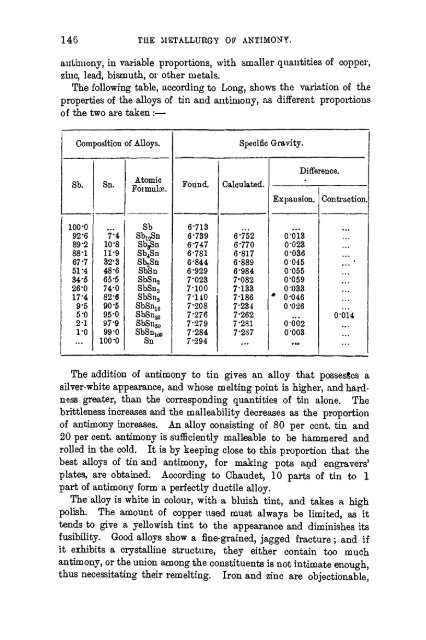A N T I M O N Y : ITS HISTORY, CHEMISTRY, MINERALOGY ...
A N T I M O N Y : ITS HISTORY, CHEMISTRY, MINERALOGY ...
A N T I M O N Y : ITS HISTORY, CHEMISTRY, MINERALOGY ...
Create successful ePaper yourself
Turn your PDF publications into a flip-book with our unique Google optimized e-Paper software.
146 THE METALLURGY OF ANTIMONY.<br />
antimony, in variable proportions, with smaller quantities of copper,<br />
zinc, lead, bismuth, or other metals.<br />
The following table, according to Long, shows the variation of the<br />
properties of the alloys of tin and antimony, as different proportions<br />
of the two are taken:—<br />
Composition of Alloys.<br />
Sb.<br />
100-0<br />
92*6<br />
89-2<br />
88*1<br />
67*7<br />
51*4<br />
34*5<br />
26-0<br />
17*4<br />
9*5<br />
5-0<br />
2*1<br />
1-0<br />
Sn.<br />
7 : 4<br />
10-8<br />
11-9<br />
32*3<br />
48-6<br />
65-5<br />
74*0<br />
82-6<br />
90*5<br />
95-0<br />
97*9<br />
99-0<br />
100-0<br />
Atomic<br />
Formulae.<br />
Sb<br />
SbjoSn<br />
SbgSn<br />
Sb4Sn<br />
Sb2Sn<br />
SbSn<br />
SbSn2<br />
SbSn3<br />
SbSn3<br />
SbSn10<br />
SbSnoo<br />
SbSugo<br />
SbSn100<br />
Sn<br />
Found.<br />
6-713<br />
6*739<br />
6747<br />
6-781<br />
6-844<br />
6-929<br />
7-023<br />
7*100<br />
7-110<br />
7-208<br />
7-276<br />
7-279<br />
7-284<br />
7-294<br />
Specific Gravity.<br />
Calculated.<br />
6-752<br />
6-770<br />
6*817<br />
6-889<br />
6*984<br />
7*082<br />
7-133<br />
7-186<br />
7*234<br />
7*262<br />
7-281<br />
7-287<br />
Expansion.<br />
0-013<br />
0*023<br />
0*036<br />
0 045<br />
0-055<br />
0-059<br />
0'033<br />
* 0-046<br />
0*026<br />
0-002<br />
0-003<br />
Difference.<br />
Contraction.<br />
o-314<br />
The addition of antimony to tin gives an alloy that possesses a<br />
silver-white appearance, and whose melting point is higher, and hardness<br />
greater, than the corresponding quantities of tin alone. The<br />
brittleness increases and the malleability decreases as the proportion<br />
of antimony increases. An alloy consisting of 80 per cent, tin and<br />
20 per cent, antimony is sufficiently malleable to be hammered and<br />
rolled in the cold. It is by keeping close to this proportion that the<br />
best alloys of tin and antimony, for making pots and engravers 7<br />
plates, are obtained. According to Chaudet, 10 parts of tin to 1<br />
part of antimony form a perfectly ductile alloy.<br />
The alloy is white in colour, with a bluish tint, and takes a high<br />
polish. The amount of copper used must always be limited, as it<br />
tends to give a yellowish tint to the appearance and diminishes its<br />
fusibility. Good alloys show a fine-grained, jagged fracture; and if<br />
it exhibits a crystalline structure, they either contain too much<br />
antimony, or the union among the constituents is not intimate enough,<br />
thus necessitating their remelting. Iron and zinc are objectionable,

















